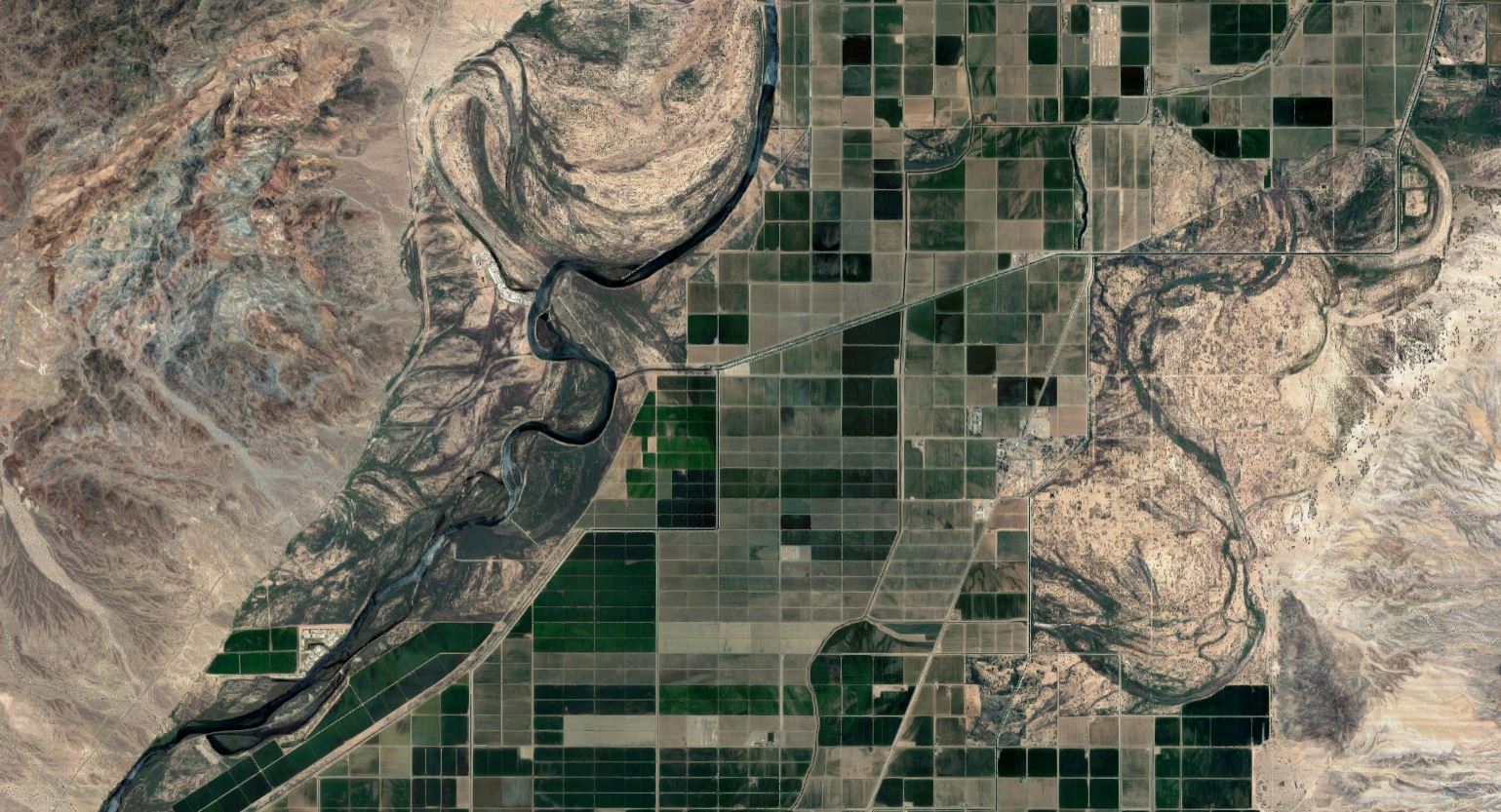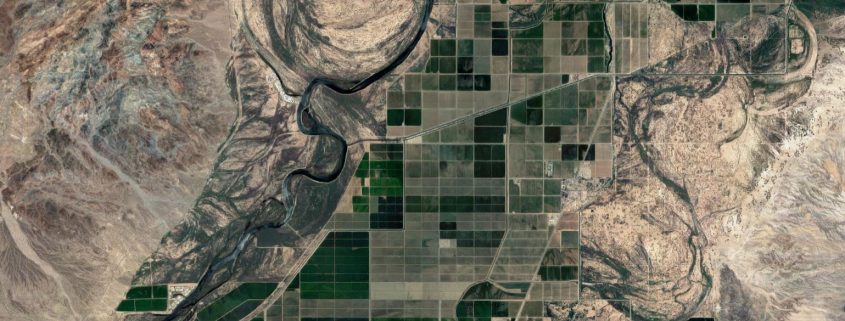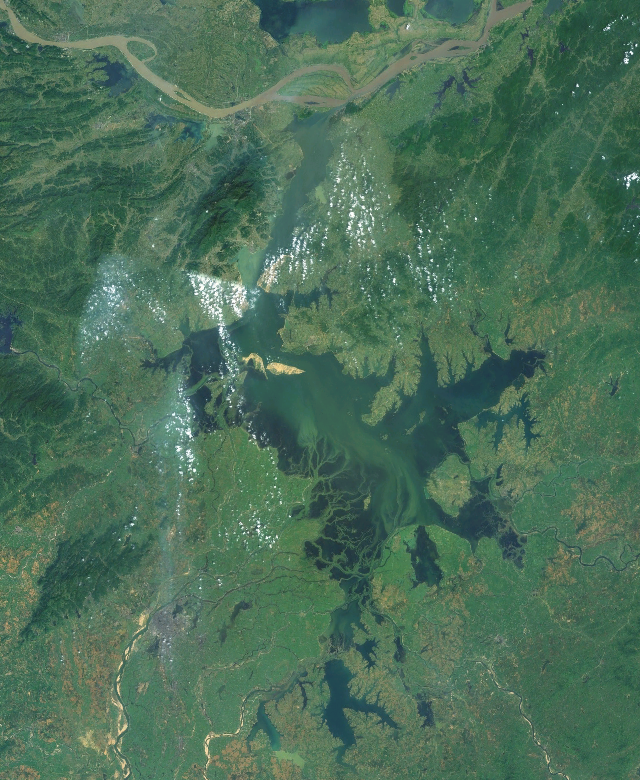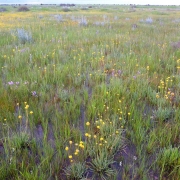With Water Leasing Vote, Colorado River Indian Tribes Will Seek Consequential Legal Change
Being allowed to move water off the reservation will greatly expand the market for water in Arizona.

The Colorado River Indian Tribes’ reservation is a patchwork of irrigated fields along the banks of the Colorado River in otherwise dry terrain. Image via Google Maps
By Brett Walton, Circle of Blue
- The leasing vote comes amid negotiations within Arizona on a drought plan to reduce Colorado River water use and preserve a shrinking Lake Mead
- The Colorado River Indian Tribes is “an enormously powerful player” in those negotiations
- Tribes, in general, are powerful players in the Colorado River basin, holding approximately 20 percent of the water rights, some 2.9 million acre-feet
Having gained an endorsement from its members, a tribe with one of the largest and most secure claims to water in the Colorado River basin will seek approval from Congress to lease water for use off of its riverside reservation.
The Colorado River Indian Tribes, or CRIT, have lands that stretch along 56 miles of the lower Colorado River. Eighty-five percent of the reservation is in Arizona, with the remainder in California. The tribe’s right to divert nearly 720,000 acre-feet from the river is more than twice the water that is allocated to the state of Nevada.
By law, that water is to be used on the reservation. But if CRIT convinces Congress to allow off-reservation leasing, the change would free up a large volume of water that would be highly desirable for cities and industries in Arizona’s fast-growing Sun Corridor, spanning Phoenix and Tucson, where four out of five state residents live.
CRIT members signaled their approval on January 19, with 63 percent voting in favor of pursuing legal changes that would allow leasing. The vote was prompted by an attempt to recall all nine tribal council members last spring over some residents’ objections to leasing.
“This referendum was a successful effort of our people to understand the value and importance of our natural resources,” Dennis Patch, CRIT chairman, said in a statement. “Our members have shown they understand that it is time to make our water work for all of us. With this responsibility in mind, our Council will continue to work on ways to protect and maximize full economic benefits for our people.”
CRIT has said that it could make as much as 150,000 acre-feet available for off-reservation use in the next decades. The tribe’s administration referred questions about the leasing vote to the attorney general, who did not return repeated phone calls from Circle of Blue.
The leasing vote comes amid negotiations within Arizona on a drought plan to reduce Colorado River water use and preserve a shrinking Lake Mead. The Bureau of Reclamation, which oversees water deliveries in the lower basin, gave Arizona lawmakers a January 31 deadline to approve the state’s plan.
Robert Glennon, a University of Arizona law professor who focuses on water policy, called CRIT “an enormously powerful player” in those negotiations.
“The tribe is absolutely critical to the willingness of the parties in Arizona to go forward with the drought plan,” Glennon told Circle of Blue. “Critical because of their willingness to put such a large amount of water on the table to prop up Lake Mead or to potentially lease water to cities.”
CRIT pledged to fallow farmland and leave 50,000 acre-feet per year in Lake Mead for three years, starting in 2020. For its effort, the tribe will be paid $38 million dollars.
CRIT’s water is desirable because the rights are among the most senior in the state, meaning they would be fulfilled before other users if all claims to the river cannot be delivered. The flow of the Colorado River is declining and the addition of heat-trapping gases in the atmosphere is causing the basin to become drier.
The relative security of senior water rights is a lure for cities, which value reliable water. Preserving that seniority is essential for any lease deal, said Mike Pearce, an attorney with Maguire, Pearce, and Storey, a water law firm in Phoenix.
“It’s an attractive marketing point and all effort would be made to protect [the status of the senior rights] if the water were to be leased,” Pearce told Circle of Blue.
Tribes, in general, are powerful players in the Colorado River basin, holding approximately 20 percent of the water rights, some 2.9 million acre-feet. In interior Arizona and in other states they have negotiated lease deals that secure long-term water availability for cities while bringing in revenue for the tribe.
CRIT hopes to be next to do so. Larry MacDonnell, a water law professor at the University of Colorado, told Circle of Blue that CRIT’s banking of water in Lake Mead is a “potentially helpful precedent” that acknowledges the tribe’s ability to provide water for use off of the reservation.
Since 2016, CRIT has participated in a small-scale water banking project, in which the tribe fallowed nearly 1,600 acres and left the conserved water, roughly 8,500 acre-feet, in Lake Mead.
Water for the Future
CRIT’s contribution to the basin’s largest reservoir is part of what’s known as the drought contingency plan, an interim blueprint for reducing Colorado River water use and preventing a catastrophic decline in Lake Mead.
A first-ever shortage, when Lake Mead’s elevation drops below 1,075 feet, could come as soon as next year. Currently at elevation 1,085 feet, the lake is 40 percent full. This month’s hydrological forecast projects the end-of-year elevation to be 1,081 feet.
Under the current operating rules, Arizona and Nevada would see their allocations reduced. The drought contingency plan seeks to bring California into the fold.
The core question for the basin is how to use less water and who will cut back. Beyond the drought plan, leasing water is one way to add flexibility to the system.
“The basic thing Arizona is looking for is water that is currently being consumptively used by someone,” Pearce said. “That’s real, wet water.” Wet water is different than paper water, which is water that exists in contracts and treaties but may not correspond to liquid in the river. Because the waters of the Colorado River were divided during a moist decade, there is more paper water in the basin than wet water.

The Central Arizona Project canal moves water from the Colorado River to interior Arizona. Photo © J. Carl Ganter/Circle of Blue
Unlike CRIT and other tribes on the mainstem of the Colorado River, tribes in interior Arizona are already allowed to lease Colorado River water. That’s because their water rights came via a state settlement in 2004 in which leasing was written into the agreement. Leased water amounted to 128,000 acre-feet in Arizona last year, according to figures provided by the Central Arizona Project.
CRIT’s water rights were determined in the seminal 1963 U.S. Supreme Court decision Arizona v. California, which settled tribal water claims in the lower basin, among other things. The tribe’s water rights, which are based on the amount of water diverted from the river, were set according to how much land on the reservation could be irrigated.
Since then, the predominant use of water on CRIT lands has been irrigation. Currently the tribe and private operators farm alfalfa, grains, cotton, melons, and other crops on about 80,000 acres, according to a Bureau of Reclamation study published in December. (Private operators can lease lands within the reservation and use CRIT’s water rights.) The study was compiled with input from the Ten Tribes Partnership, a coalition of tribes including CRIT that have water rights in the Colorado River basin.
CRIT’s water use could change substantially in the future. In the Bureau of Reclamation study, CRIT developed four water-use scenarios that extend to 2060.
Much of the irrigation on CRIT farmland is flood irrigation, an inefficient way to raise a crop. Under two higher-growth scenarios, irrigation becomes more efficient on the tribe’s Arizona land, and thus consumes more water because the tribe’s rights are based on diversions. At the same time, the California side of the reservation begins to use its allocation for irrigation. Today, there is inadequate irrigation infrastructure on the tribe’s California land, and it diverts less than 5,000 acre-feet of its annual 56,000 acre-feet allocation for that section of the reservation.
In those same two scenarios, the tribe begins to lease water in Arizona — but not in California — eventually reaching 150,000 acre-feet by 2060. CRIT’s consumptive water use, meaning water that is not available for downstream users, rises accordingly, increasing between 40 percent and 50 percent depending on the scenario.
Brett writes about agriculture, energy, infrastructure, and the politics and economics of water in the United States. He also writes the Federal Water Tap, Circle of Blue’s weekly digest of U.S. government water news. He is the winner of two Society of Environmental Journalists reporting awards, one of the top honors in American environmental journalism: first place for explanatory reporting for a series on septic system pollution in the United States(2016) and third place for beat reporting in a small market (2014). He received the Sierra Club’s Distinguished Service Award in 2018. Brett lives in Seattle, where he hikes the mountains and bakes pies. Contact Brett Walton











The necessity for water sources to be managed more effectively is becoming critical all over the world. Any actions towards more sustainable outcomes is a step in the right direction.